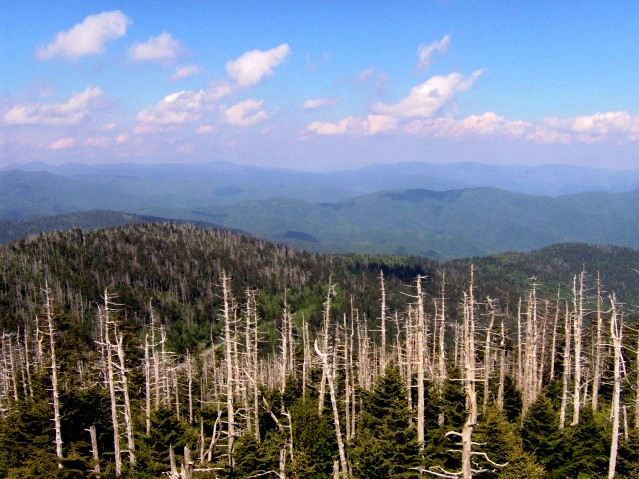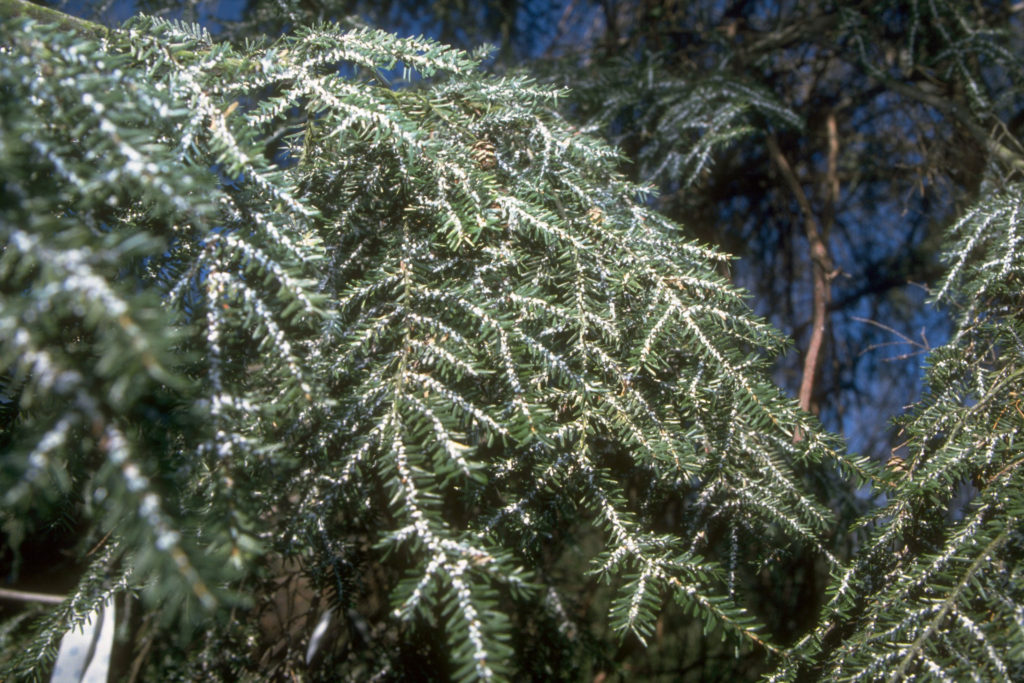
Clingman’s Dome, Tennessee
A recent study provides an overview of the threat non-native insects pose to conifers in North America. Unfortunately, pathogens are not included in the study. I provide a citation to the study (Mech et al., 2019) at the end of this blog.
The study’s authors based their analysis on 58 insects that specialize on conifers (trees in the families Cupressaceae, Pinaceae, and/or Taxaceae). These were derived from a list of over 500 herbivorous insects identified by Aukema et al. (2010) and Yamanaka et al. (2015). Mech and colleagues determined that of the approximately 100 conifer species native to North America, 49 have been colonized by one or more of these 58 non-native insects. Three-quarters of the affected trees have been attacked by more than one non-native insect. One tree species was attacked by 21 non-native insects.
Looked at from the opposite perspective, one of the insects attacked 16 novel North American hosts.
Of these 58 insects, only six are causing high impacts, all in the orders Hymenoptera (i.e., sawflies) and Hemiptera (i.e., adelgids, aphids, and scales). (“High impact” is defined as causing mortality in the localized host population, recognizing potential spread.)
These six are (1) Adelges piceae—balsam woolly adelgid; (2) Adelges tsugae—hemlock woolly adelgid; (3) Elatobium abietinum—green spruce aphid; (4) Gilpinia hercyniae—European spruce sawfly; (5) Matsucoccus matsumurae—red pine scale; and (6) Pristiphora erichsonii—larch sawfly. The high-impact pests included no wood borers, root feeders, or gall makers.
Mech and colleagues analyzed these relationships in an effort to determine factors driving bioinvaders’ impacts. They evaluated the probability of a non-native conifer specialist insect causing high impact on a novel North American host as a function of the following: (a) evolutionary divergence time between native and novel hosts; (b) life history traits of the novel host; (c) evolutionary relationship of the non-native insect to native insects that have coevolved with the shared North American host; and/or (d) the life history traits of the non-native insect.
They found that the major drivers of impact severity for those that feed on foliage and sap (remember, they did not evaluate other feeding guilds) were:
1) Host’s evolutionary history – Divergence time in millions of years (mya) since North American species diverged from a coevolved host of the insect in its native range. The greatest probability of high impact for a leaf-feeding specialist was on a novel conifer that diverged from the native conifer host recently (~1.5–5 mya). The divergence time for peak impact was longer for sap‐feeders (~12–17 mya). The predictive power of the divergence-time factor was stronger for sap-feeders than for leaf feeders.
2) Shade tolerance and drought intolerance – A tree species with greater shade tolerance and lower drought tolerance is more vulnerable to severe impacts. This profile fits most species of Abies, Picea, and Tsuga. On the other hand, novel hosts with low shade tolerance and higher drought tolerance had a very low likelihood of suffering severe impacts.

3) Insect evolutionary history – When a non-native insect shares a host with a closely related herbivore native to North America, the invader is less likely to cause severe impacts. However, this factor in isolation had relatively poor predictive performance.
None of the insect life history traits examined, singly or in combination, had predictive value. The traits evaluated were feeding guild, native region, pest status in native range, number of native host genera, voltinism (frequency of egg-laying periods), reproductive strategy, fecundity, and/or mechanism of dispersal.
See Mech et al. (2019) for a discussion of hypotheses that might explain these findings.
My Questions Answered!
The authors inform me that their project will eventually include introduced insects attacking all kinds of trees. The more than 500 insect species that utilize woody hosts have been placed into one of three categories: 1) conifer specialist (only utilizes conifer hosts), 2) hardwood/woody angiosperm specialist (only utilizes hosts in a single angiosperm family), or 3) generalists (utilizes hosts in more than one angiosperm family or both angiosperms and conifers) (Mech pers. comm.) They began with the smallest group – the conifer specialists – so that they could more easily work out kinks in their procedures.
I had asked why the brown spruce longhorned beetle (Tetropium fuscum) – which is established in Nova Scotia – was not included in this study. According to the authors, this cerambycid beetle has been reported to feed occasionally on hardwood species, so it has been placed in the third group.noted above.
SOURCES
Aukema, J.E., D.G. McCullough, B. Von Holle, A.M. Liebhold, K. Britton, & S.J. Frankel. 2010. Historical Accumulation of Nonindigenous Forest Pests in the Continental United States. Bioscience. December 2010 / Vol. 60 No. 11
Mech, A.M., K.A. Thomas, T.D. Marsico, D.A. Herms, C.R. Allen, M.P. Ayres, K.J. K. Gandhi, J. Gurevitch, N.P. Havill, R.A. Hufbauer, A.M. Liebhold, K.F. Raffa, A.N. Schulz, D.R. Uden, & P.C. Tobin. 2019. Evolutionary history predicts high-impact invasions by herbivorous insects. Ecol Evol. 2019 Nov; 9(21): 12216–12230.
Yamanaka, T., Morimoto, N. , Nishida, G. M. , Kiritani, K. , Moriya, S. , & Liebhold, A. M. (2015). Comparison of insect invasions in North America, Japan and their Islands. Biological Invasions, 17, 3049–3061. 10.1007/s10530-015-0935-y [CrossRef] [Google Scholar]
Posted by Faith Campbell
We welcome comments that supplement or correct factual information, suggest new approaches, or promote thoughtful consideration. We post comments that disagree with us — but not those we judge to be not civil or inflammatory.
Thank you for the summary of our study to predict high-impact non-native conifer pests! Angela Mech and I have some responses to the questions posed at the end of the blog:
1) “Is anyone doing a similar study of hardwoods? Clearly there are differences – many woodborers are causing devastating impacts.”
Yes! We’re currently wrapping up a study looking at woody angiosperm specialists and we’ve also begun tackling generalist species.
2) “Would inclusion of additional species change the results?”
As more resources become available, more conifer specialists will undoubtedly be found that could be added to the database, but we believe that the major trends captured by these data are unlikely to change.
3) “The article … does not include the brown spruce longhorned beetle…Are there other species introduced to Canada that are also not included?”
Spruce longhorned beetle is reported to feed on some hardwoods so by our definition for this analysis, it is not a conifer specialist. We did include other species only found in Canada
We also want to note that we evaluated all feeding guilds to find the drivers of impact; but because of a significant interaction term, host evolutionary history was the only driver evaluated separately for sap-feeders and folivores.
We think this approach is useful for predicting high-impact non-native pests, and look forward to it being expanded to other hosts and regions. We hope it can make regulatory and management efforts more efficient!